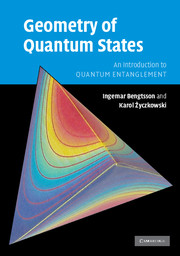Book contents
- Frontmatter
- Contents
- Preface
- 1 Convexity, colours and statistics
- 2 Geometry of probability distributions
- 3 Much ado about spheres
- 4 Complex projective spaces
- 5 Outline of quantum mechanics
- 6 Coherent states and group actions
- 7 The stellar representation
- 8 The space of density matrices
- 9 Purification of mixed quantum states
- 10 Quantum operations
- 11 Duality: maps versus states
- 12 Density matrices and entropies
- 13 Distinguishability measures
- 14 Monotone metrics and measures
- 15 Quantum entanglement
- Epilogue
- Appendix 1 Basic notions of differential geometry
- Appendix 2 Basic notions of group theory
- Appendix 3 Geometry: do it yourself
- Appendix 4 Hints and answers to the exercises
- References
- Index
14 - Monotone metrics and measures
Published online by Cambridge University Press: 27 August 2009
- Frontmatter
- Contents
- Preface
- 1 Convexity, colours and statistics
- 2 Geometry of probability distributions
- 3 Much ado about spheres
- 4 Complex projective spaces
- 5 Outline of quantum mechanics
- 6 Coherent states and group actions
- 7 The stellar representation
- 8 The space of density matrices
- 9 Purification of mixed quantum states
- 10 Quantum operations
- 11 Duality: maps versus states
- 12 Density matrices and entropies
- 13 Distinguishability measures
- 14 Monotone metrics and measures
- 15 Quantum entanglement
- Epilogue
- Appendix 1 Basic notions of differential geometry
- Appendix 2 Basic notions of group theory
- Appendix 3 Geometry: do it yourself
- Appendix 4 Hints and answers to the exercises
- References
- Index
Summary
Probability theory is a measure theory – with a soul.
Mark KacSection 2.6 was devoted to classical ensembles, that is to say ensembles defined by probability measures on the set of classical probability distributions over N events. In this chapter quantum ensembles are defined by choosing probability measures on the set of density matrices of size N. A warning should be issued first: there is no single, naturally distinguished measure in M(N), so we have to analyse several measures, each of them with different physical motivations, advantages and drawbacks. This is in contrast to the set of pure quantum states, where the Fubini–Study measure is the only natural choice for a measure that defines ‘random states’.
A simple way to define a probability measure goes through a metric. Hence we will start this chapter with a review of the metrics defined on the set of mixed quantum states.
Monotone metrics
In Section 2.5 we explained how the Fisher metric holds its distinguished position due to the theorem of Čencov, which states that the Fisher metric is the unique monotone metric on the probability simplex ΔN–1. Now that the latter has been replaced by the space of quantum states M(N) we must look again at the question of metrics. Since the uniqueness in the classical case came from the behaviour under stochastic maps, we turn our attention to stochastic quantum maps – the completely positive, trace preserving maps discussed in Chapter 10. A distance D in the space of quantum states M(N) is called monotone if it does not grow under the action of a stochastic map Φ, If a monotone distance is geodesic the corresponding metric on M(N) is called monotone.
Information
- Type
- Chapter
- Information
- Geometry of Quantum StatesAn Introduction to Quantum Entanglement, pp. 339 - 362Publisher: Cambridge University PressPrint publication year: 2006
